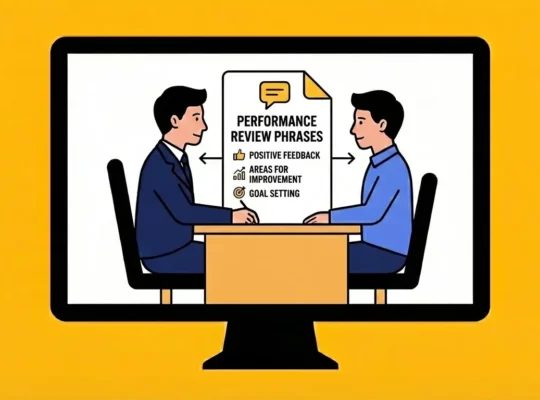Are you struggling to gather meaningful feedback from your employees or to bridge the gap in communication with remote and global teams? Employee feedback tools are no longer optional—they’re essential for companies aiming to stay competitive in today’s dynamic business landscape. At Review.jobs, we know the power of genuine employee insights in transforming workplace culture and driving growth. In this guide, we’ll uncover how these tools work, their key benefits, and the top solutions to help you tackle today’s workplace challenges head-on.
Table of Contents
- I. Overview of Employee Feedback Tools
II. Key Features of Effective Employee Feedback Tools
III. Top 10 Employee Feedback Tools
1. Review.jobs
2. Engagedly
3. CultureMonkey
4. Leapsome
5. DeskAlerts
6. Officevibe
7. Qualtrics
8. Trackstar
9. Worktango
10. TinyPulse
IV. Choosing the Right Tool for Your Organization
V. Benefits of Implementing Employee Feedback Tools
I. Overview of Employee Feedback Tools
Definition of Employee Feedback Tools
Employee feedback tools are specialized software designed to facilitate the collection, analysis, and management of employee feedback within an organization. These tools allow companies to conduct surveys, gather real-time responses, and track changes in employee sentiment over time. Typically, these platforms offer features like anonymous surveys, pulse surveys, continuous feedback mechanisms, and 360-degree reviews. The aim is to create an easy-to-use system where feedback can be systematically collected and converted into actionable insights.
The Role of Feedback Tools in Enhancing Employee Engagement and Productivity
Long gone are the traditional barriers that can stifle open exchanges. By enabling regular and structured interactions, feedback tools ensure that employees feel heard and valued, which is a fundamental component of job satisfaction and motivation. Needless to say, communication is a powerful lever for the development of the employer brand and boosting engagement and productivity. They are crucial in fostering a workplace where engagement and productivity flourish by facilitating an ongoing dialogue between employees and management. They help in several ways:
- Real-Time Insights: These tools provide managers and leaders with real-time insights into team morale and engagement, allowing for swift actions and responses to any emerging issues.
- Honest Communication: With features like anonymous feedback, employees feel safer to express real concerns and suggestions without fear of reprisal.
- Performance Enhancement: Regular and structured feedback helps in identifying areas of improvement, aligning employee goals with organizational objectives, and recognizing achievements, which are crucial for driving performance.
- Cultural Impact: By encouraging open dialogue, feedback tools help cultivate a positive workplace culture, where employees are motivated and feel valued.
The strategic use of employee feedback tools can lead to a more harmonious and productive workplace, with a clear alignment between individual performance and broader business goals. These platforms enable managers to not just hear but act on the insights provided, leading to significant improvements in work dynamics and outcomes.
II. Key Features of Effective Employee Feedback Tools
1. Anonymity in Feedback for Honest Communication
One of the fundamental features of effective employee feedback tools is the provision of anonymous feedback options. This feature encourages employees to share candid feedback without the fear of negative repercussions. Anonymity ensures that the feedback collected is genuine, which is crucial for leaders to understand the true sentiments and concerns of their teams. It fosters a culture of trust and openness, where employees feel their voices can be heard honestly.
2. Real-Time Analytics and Reporting for Timely Insights
Advanced employee feedback tools are equipped with real-time analytics and reporting capabilities. This allows managers and HR professionals to monitor engagement and performance metrics actively, providing immediate insights into the health of the organization. Timely data enables leadership to make informed decisions quickly, address issues as they arise, and capitalize on opportunities to boost morale and productivity.
3. Integration Capabilities with Other HR Systems
Integration capabilities are crucial for modern employee feedback tools, as they allow for seamless connectivity with other HR software systems. This integration supports a holistic approach to employee management by consolidating data across various platforms, such as performance management systems, learning management systems, and payroll software. This connectivity ensures that feedback is integrated into all aspects of HR processes, enhancing the strategic use of insights for better management.
4. User-Friendly Interfaces for Broad Adoption
For employee feedback tools to be effective, they must be accessible and easy to use for everyone within the organization. User-friendly interfaces encourage broader adoption, ensuring that all team members, regardless of their technical proficiency, can easily provide feedback. Simplicity in design and ease of use are key to achieving high participation rates, which in turn, increases the data’s accuracy and usefulness.
When employees find the tool easy to engage with, they are more likely to use it regularly and provide the ongoing feedback that is so valuable to organizational growth. Needless to say, high participation rates are essential not just for the quantity but also for the quality of the data collected. With more employees feeling empowered to voice their opinions and share their experiences, the feedback becomes more representative of the entire workforce. This inclusivity enhances the accuracy of the feedback, providing a more complete and nuanced picture of the organizational climate.
5. Support for Various Types of Feedback
Diverse feedback mechanisms are essential to address the different needs and contexts of an organization. This diversity in feedback tools and methods allows organizations to effectively engage with employees across different departments, seniority levels, and geographical locations, accommodating a wide range of communication styles and preferences. Effective employee feedback tools support various types of feedback:
- Pulse surveys offer quick, frequent snapshots of employee sentiment, allowing companies to take the pulse of their workforce regularly.
- 360-degree feedback provides a comprehensive view of an employee’s performance, gathering inputs from peers, subordinates, and supervisors.
- Continuous feedback mechanisms facilitate an ongoing conversation about performance and goals between employees and managers.
By accommodating these varied feedback types, organizations can tailor their approach to fit their unique culture and management style, promoting a dynamic environment where continuous improvement is the norm.
III. Top 10 Employee Feedback Tools
Instead of scouring the internet for hours on end, check this detailed overview of 10 software that you must consider while searching for the perfect employee feedback tool for your organization:
1. Review.jobs
Review.jobs is a certified platform that not only helps businesses manage employee feedback but also uses this data to enhance the online reputation and employer branding of the user businesses. This tool is designed to support HR departments in collecting, moderating, and publishing employee reviews efficiently and transparently, adhering to the highest international standards for data handling and privacy. Review.jobs leverages authentic employee reviews to build an authentic employer brand.
Key Features:
- ISO-Certified Review Management
- Employee Reviews: Enables confidential reviews providing valuable insights for job seekers and employers
- Company Transparency: Encourages an open environment by sharing employee ratings on culture, management, and work-life balance
- Feedback Analysis: Advanced tools for identifying trends and areas for improvement
- AI-driven Insights: Employs sophisticated algorithms for deeper understanding and decision-making
2. Engagedly
Engagedly integrates multiple facets of employee feedback, engagement, and development into a unified performance management tool. It supports a dynamic environment where continuous growth and development are prioritized. This platform is especially beneficial in enhancing communication between managers and their teams through structured feedback and goal alignment.
Key Features:
- Performance Reviews
- Goal Management
- Real-time Feedback
- Learning Modules: Enhances workforce engagement and skills development
- Customizable Feedback Categories
- Automated Workflows
3. CultureMonkey
CultureMonkey specializes in strengthening company culture through carefully designed employee surveys that deliver actionable insights. This tool is particularly adept at helping organizations understand and improve employee sentiment, thus enhancing overall engagement and satisfaction. CultureMonkey stands out for its ability to handle feedback in multiple languages, making it ideal for global organizations.
Key Features:
- Extensive Survey Templates
- Integration with HRMS Tools
- Multilingual Feedback: Adaptable to global workforce requirements
4. Leapsome
Leapsome provides an all-in-one platform that merges tools for performance management, employee engagement, and personalized learning. It facilitates a culture of regular feedback and development, supporting continuous improvement and alignment between personal goals and organizational objectives. Leapsome is particularly focused on nurturing a culture that values ongoing feedback and development.
Key Features:
- Performance Reviews
- Goal Management
- Continuous Feedback
- Special focus on cultivating a feedback-oriented culture
5. DeskAlerts
DeskAlerts offers an innovative solution for communication within organizations, focusing on emergency alerts, internal communications, and incident management. It is particularly effective in situations that require immediate attention and action, making it a vital tool for real-time feedback and prompt responses.
Key Features:
- Emergency Alerts
- Internal Communications
- Real-time Feedback through surveys and quizzes
- Focus on disruptive, immediate alerts for urgent communication needs
6. Officevibe
Officevibe, created by WorkLeap, provides a robust platform for managing workforce performance and engagement through continuous feedback mechanisms. It is designed to enhance employee satisfaction and productivity, thereby aiding in better retention strategies and overall organizational health.
Key Features:
- Continuous Feedback
- Performance Tracking
- Insights into Employee Satisfaction
- Regular, Short Surveys
- Anonymous Feedback
- Custom Reports
- Goal Alignment with Managers
7. Qualtrics
As a leader in experience management, Qualtrics offers a suite of tools that encompass employee, customer, and brand experiences. This platform helps companies harness insights across these areas, driving significant improvements based on comprehensive feedback analysis.
Key Features:
- Comprehensive Feedback Gathering
- Real-time Insights
- Powerful Analytics Tools
- Feedback Across Various Touchpoints
- Automatic Responses or Alerts based on feedback scores
8. Trackstar
Trakstar helps modernize performance appraisals by offering customizable software that supports the continuous tracking and management of employee performance. This tool is ideal for aligning employee performance with strategic company goals, thereby fostering a development-focused work environment.
Key Features:
- Customizable Performance Review Templates
- Goal Tracking
- Ongoing Feedback
- Integration with Learning Management Systems
9. Worktango
WorkTango empowers organizations by giving employees a voice through its advanced feedback and survey tools. This platform is focused on improving engagement and aligning employee goals with organizational objectives, which is crucial for maintaining a motivated and aligned workforce.
Key Features:
- Integrated Rewards System
- Continuous Dialogue
- Tools for Peer Recognition and Rewards
10. TINYpulse
TinyPulse is a platform designed to boost employee engagement by providing a simple yet effective way for employees to share feedback. It aims to create a transparent and communicative work environment where employee sentiments are heard and addressed promptly, fostering a culture of continuous improvement and satisfaction.
Key Features:
- Anonymous Feedback Channels
- Pulse Surveys
- Real-Time Reporting
IV. Choosing the Right Tool for Your Organization
Selecting the ideal employee feedback tool involves careful consideration of several factors tailored to your organization’s specific context.
Company Size
The scale of your business can determine the complexity and scalability of the feedback tool needed. Larger organizations may require more robust systems with extensive integration capabilities, while smaller firms might benefit from simpler, more direct platforms.
Specific Needs
Identify the primary challenges and objectives of your feedback initiatives. Whether it’s improving communication, tracking performance, or enhancing engagement, the tool should directly address these needs.
Employee Demographics
Consider the demographics of your workforce, including age, tech-savviness, and cultural background. A tool that resonates well with your employee demographic will see higher engagement and more accurate feedback.
Importance of Trial Periods and Customization Options
Opting for tools with trial periods allows your organization to evaluate the software in real-world conditions without a long-term commitment. This hands-on experience can reveal whether the tool’s features align with your needs and how intuitive the interface is for your users.
Additionally, customization options are crucial as they allow the tool to be tailored to fit the specific feedback and reporting styles preferred by your organization. This adaptability ensures that the tool remains effective as your company evolves and its needs change.
V. Benefits of Implementing Employee Feedback Tools
Implementing the right employee feedback tools can profoundly influence various aspects of organizational health. These tools ensure employees feel heard and valued, which not only increases job satisfaction and collaboration but also supports effective management and leadership practices. This translates into a more transparent, responsive, and inclusive work environment, leading to scalable improvements in several key areas.
1. Direct Impact on Employee Morale and Retention
Employee feedback tools can significantly boost morale by showing staff that their opinions are valued, boosting job satisfaction, and reducing turnover rates. These tools facilitate a two-way conversation where employees feel listened to and appreciated.
By providing a platform where feedback is not just collected but also acted upon, organizations can quickly address concerns and make adjustments that reflect the needs and preferences of their workforce. This responsive approach helps employees feel that they are genuinely listened to—a factor that can transform their engagement and overall workplace happiness.
2. Enhanced Communication Between Teams and Leadership
Feedback tools bridge the communication gap between employees and management. They provide a platform for honest and regular feedback, which helps leadership understand employee needs, expectations, and concerns.
This improved communication fosters a transparent feedback culture where employees can contribute to important discussions and decisions, enhancing trust across all levels of the organization.
3. Data-Driven Decisions Based on Comprehensive Feedback Analysis
One of the most significant advantages of using advanced feedback tools is their ability to analyze large volumes of data to uncover trends and patterns. This data-driven approach allows leaders to make informed decisions that are backed by real employee feedback rather than assumptions. It enables companies to strategically address areas needing improvement and to recognize and replicate success factors. The result: better business outcomes and a more engaging workplace environment.
Employing the right employee feedback tools offers a strategic advantage that is essential for any business aiming to maintain a competitive edge. These tools enhance workplace communication and decision-making and boost your employer image makeover campaign. As businesses continue to evolve, the need for advanced, insightful feedback mechanisms becomes ever more critical. Review.jobs encourages organizations to reassess their current feedback systems and consider upgrading to more sophisticated solutions that can provide deeper insights and foster a more engaged workforce. Now is the time to enhance your feedback strategy and take a decisive step towards a more productive and satisfied team.





